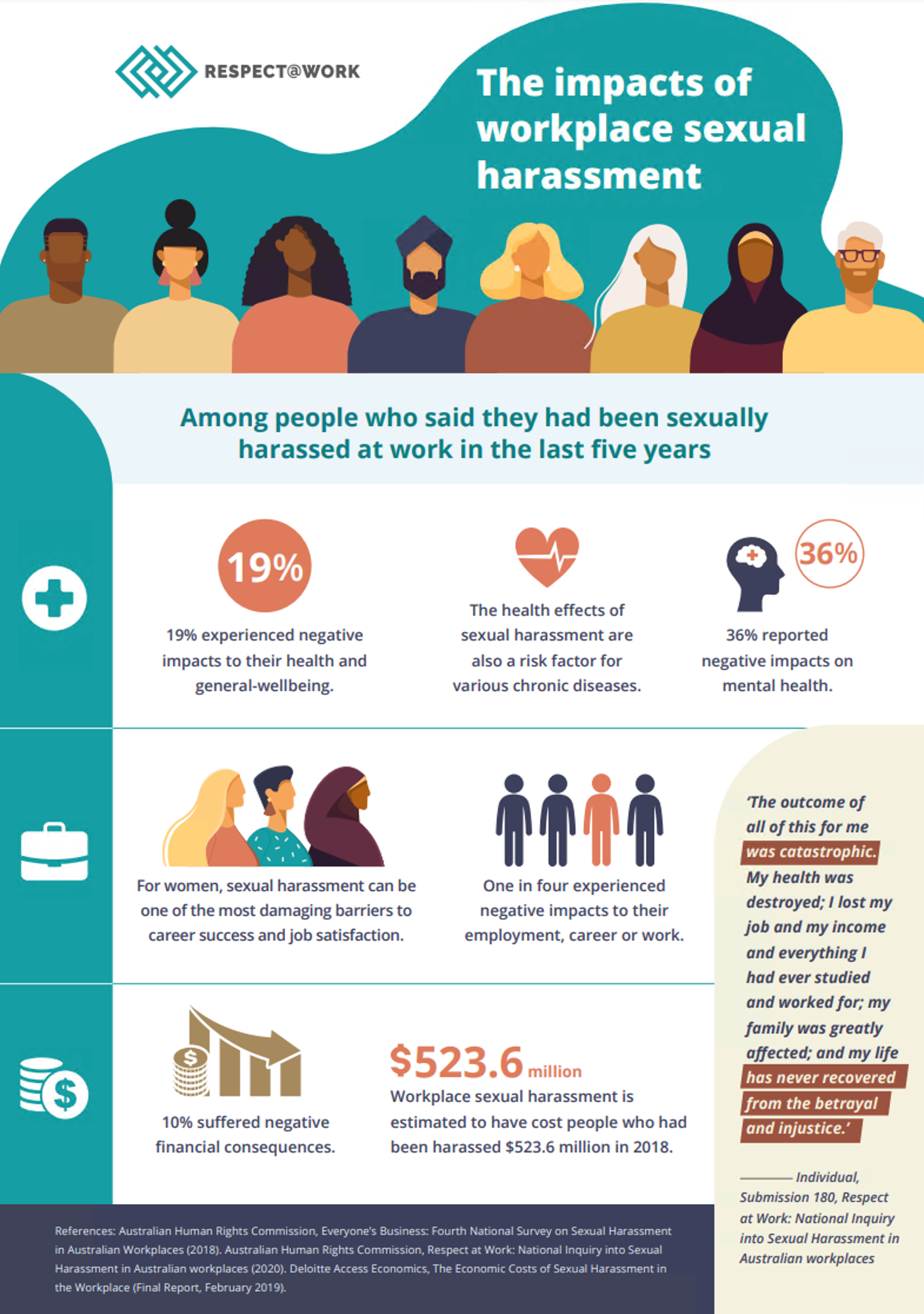The impacts of workplace sexual harassment
What are the short and long term impacts of workplace sexual harassment?

Workplace sexual harassment can have profound and devastating impacts.
Given each person’s experience of workplace sexual harassment may differ, so too will the impacts on them. While two individuals may share a similar diagnosis, their treatment requirements and recovery period could be vastly different to one another.
A person’s gender, experiences of discrimination and disadvantage, and the nature of the harassment they experiences can all contribute to the varied impacts of workplace sexual harassment. It is important that any responses that are designed to support a person harassed, consider these varying experiences.
It is important to consider that workplace sexual harassment, and its resulting impacts and consequences, are preventable.
Impacts on the person harassed
Workplace sexual harassment can have wide ranging impacts on the health of people harassed, including on:
- Mental health impacts: people harassed commonly experience a range of mental health conditions including stress, anxiety, depression and post-traumatic stress disorder (PTSD). Over 1 in 3 people harassed reported stress and negative impacts on mental health. Self-esteem, self-confidence and ability to trust others can also be negatively impacted. Individuals may retreat from their work as a result.
- Physical health impacts: the mental health effects of sexual harassment (including psychological distress, stress, depression, anxiety and PTSD) are risk factors for various chronic diseases, blood pressure issues, obesity, hypertension, cardiovascular disease, and some cancers. Some people who have been harassed also suffer from physical injury as a result of a physical violence/assault.
- General health and welfare: nearly 1 in 5 people who said they had been sexually harassed at work in the last five years experienced negative impacts to their health and welfare following the most recent incident
Impacts on employment, career or work
1 in 4 people who said they were sexually harassed in the workplace in the last five years experienced negative impacts to their employment, career or work as a result of the most recent incident.
Some people harassed may be forced to implement strategies to prioritise their safety and in doing so, limit opportunities for career growth. For example:
- using sick leave and annual leave to avoid harassers in the workplace
- avoiding certain activities which may have led to building social networks and career progression, such as social events or training opportunities
- leaving their jobs all together
- leaving the sector they have built their career in.
- Research has indicated that for women, workplace sexual harassment can be one of the most damaging barriers to career success and job satisfaction.
Financial impacts
The 2018 National Survey indicated that 1 in 10 people who said they were sexually harassed in the workplace in the last five years suffered negative financial consequences because of the most recent incident.
Repeated voluntary and involuntary career interruptions, and the need to retrain following a change in industry or sector, can impact on long-term earning capacity and superannuation accrual. Some research has indicated that the financial impacts of workplace sexual harassment are felt more acutely by women, as they are more likely than men to make lateral moves or take pay cuts in order to escape their harasser.
Deloitte Access Economics estimated that in 2018, the cost of workplace sexual harassment to people harassed was $523.6 million. This includes costs related to the negative impacts on wellbeing, lost income as a result of taking unpaid leave or a period of unemployment, and costs associated with accessing the health and justice systems. This figure does not account for the long-term impacts of sexual harassment on individuals’ long-term career progression and workplace participation. There are also significant costs for workplaces and the broader economy.
The financial burden of accessing ongoing support is nearly always carried by the person harassed, particularly those pursuing legal remedies. In 2018, individuals who were harassed spent $103.5 million in accessing the health and justice systems.


